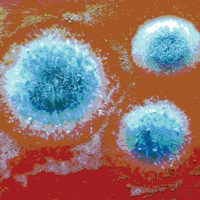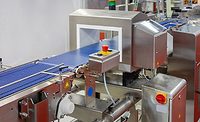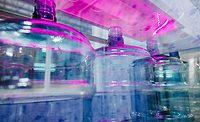The Missing Element in Microbiological Food Safety Inspection Approaches, Part 2

Recent and past experiences involving contamination of foods with unexpected microbes indicate the need for enhanced approaches to microbiological food safety. The purpose of food safety programs should be to keep harmful agents such as chemicals, allergens, extraneous matter (insects, metal filings, rubber, plastic, etc.) and microbes out of the food supply.
Part 1 of this article revealed the need for walk-through microbiological risk assessments as a critical supplement to food safety and quality systems assessments. This approach can be applied to both one’s own facility and those providing ingredients that may pose microbiological concerns in the finished product. These assessments may be conducted by outside third parties or in-house experts. A combination of both is recommended.
In-plant Microbiological Risk Assessments
This type of risk assessment is quite different from the type that is often discussed in academic circles. It has little to do with statistics and probability, but everything to do with observations in the plant related to where microbes have grown in localized “niches.” It is certainly impractical, and likely impossible, to expect food-processing facilities to be sterile. However, microbial growth in processing facilities can be controlled.
.jpg) Microbial growth niches occur when moisture, nutrition, time and growth-conducive temperatures occur in a non-sterile environment (Figure 1). Adequate nutrition for microbial growth is typically in abundance in food-processing environments. Even dust particles may contain enough nutrition to grow microbes to high numbers in small volumes of fluid or localized moist areas. Time abounds, particularly in areas missed or inaccessible for cleaning. Microbial growth can occur over a wide range of temperatures between approximately 32 and 140 °F, readily found in most processing environments. Moisture is absolutely necessary for microbial growth; hence, its control is essential.
Microbial growth niches occur when moisture, nutrition, time and growth-conducive temperatures occur in a non-sterile environment (Figure 1). Adequate nutrition for microbial growth is typically in abundance in food-processing environments. Even dust particles may contain enough nutrition to grow microbes to high numbers in small volumes of fluid or localized moist areas. Time abounds, particularly in areas missed or inaccessible for cleaning. Microbial growth can occur over a wide range of temperatures between approximately 32 and 140 °F, readily found in most processing environments. Moisture is absolutely necessary for microbial growth; hence, its control is essential.
Sites with likely microbial growth are those in which moisture is entrapped (e.g., wet insulation, roof leaks, water marks, hollow conveyor rollers, duct-taped pipe leaks, sandwiched areas associated with equipment such as slicers, conveyor guides, product scrapers, etc.). A list of sites related to Listeria niches is found in Kornacki and Gurtler.[1]
Gabis and Faust[2] wrote that “the probability of product contamination from the environment is dependent upon a number of variables.” They then listed those as follows:
• Proximity of microbial growth niches to the product stream
• Number of niches in the food processing facility
• Spatial relationships of niches and the product stream
• Microbial population in niches
• Degree of niche disruption during operations
• Exposure of the product stream to the environment
Those variables can then be applied to the assignment of relative risk associated with sites throughout the plant.
Prioritization of Risk Associated with Specific Sites
The walk-through microbiological risk assessment should focus on observing and sampling sites conducive to growth. These sites can be broken down into those areas that have high, medium and indirect risks of contaminating the product stream. In the last article, those areas were defined as follows:
High risk – an area or practice that may directly contaminate the product either continuously or intermittently
Medium risk – similar to “high risk” but mitigating factors (e.g., exposure to mild antimicrobial agents or treatments, or dilution in air or water) may reduce risk by an undetermined amount
Indirect risk – any situation or condition likely to develop into a microbial growth niche (such as standing water in a hallway) that could migrate to another site and thereby become a growth niche capable of inoculating product at a detectable level
It is important to recognize that “indirect” risk is not the same thing as “low” risk. Some indirect risks should be given high priority in terms of remediation as they may be sources of continuing inoculation of the general plant environment. Prioritizing indirect risk sites for remediation should be determined on a case-by-case basis. However, no system is foolproof. Therefore, this article will address some of the potential pitfalls to this approach.
Pitfalls to the Walk-through Risk Assessment Approach
Despite the absolute need for an investigatory mindset in the context of a walk-through risk assessment as supplemental to traditional checklist auditing, this approach is not without pitfalls. These pitfalls have to do with assumptions. Stephen J. Gould is quoted as saying, “Most impediments to scientific understanding are conceptual locks, not factual links…”[3] Often, our beliefs preclude appropriate observations and sampling. Examples of false assumptions are addressed below.
 “There is (are) a gasket(s) to prevent product contamination.” On any number of occasions, I have heard this phrase only to find, after sampling, that product residues associated with gasketing have actually turned out to be a source of contamination to the product stream. In Figure 2, soiled gasketing was not removed for cleaning due to reliance upon the plant’s clean-in-place (CIP) system. The assumption was made that the gasket would prevent contamination from entering the product stream. In this instance, the opposite was true, as the gasket proved to be a source of contamination of dry finished product with a pathogenic microbe.
“There is (are) a gasket(s) to prevent product contamination.” On any number of occasions, I have heard this phrase only to find, after sampling, that product residues associated with gasketing have actually turned out to be a source of contamination to the product stream. In Figure 2, soiled gasketing was not removed for cleaning due to reliance upon the plant’s clean-in-place (CIP) system. The assumption was made that the gasket would prevent contamination from entering the product stream. In this instance, the opposite was true, as the gasket proved to be a source of contamination of dry finished product with a pathogenic microbe.
“The product cannot support microbial growth, and therefore, the microbes cannot survive.” The implication is that because bacteria cannot grow in dry, frozen and low-pH foods that therefore they must die. This cannot be relied upon to occur. Failure to grow does not necessarily mean microbial death. It is useful to remember that freeze drying is a means to preserve bacterial cultures.
.jpg) Table 1 illustrates selected examples of foodborne illness or pathogen isolations occurring in such foods.
Table 1 illustrates selected examples of foodborne illness or pathogen isolations occurring in such foods.
“It (the piece of equipment) has been CIPed or COPed; therefore, it cannot be contaminated.” In my experience, CIP means different things in different industries. In some industries, (e.g., fluid milk), CIP is a well-defined system: turbulent flow is achieved, chemical strength and temperatures are monitored, timing pumps are State-sealed and there are few failures. In other instances, all that CIP may mean to a particular plant’s operating culture/philosophy is that a spray ball was connected to a supply line of chemicals and water, but turbulent flow and treatment efficacies were not validated. In these cases, the name CIP can give a false sense of security and preclude investigatory sampling. In my experience, pathogens have been isolated from a variety of CIPed equipment, as noted above.
Other sites of potential contamination or elevated microbiological risk to product include poorly maintained or infrequently inspected CIP “pop-outs.” Small particulates can keep the valves from sealing properly, resulting in rinse water dripping into a product stream during operations. These wet conditions can result in microbial growth niches in either the product stream or the valve.
In other cases, CIP spray balls were not removed, resulting in product and moisture accumulation over the product stream. This is an ideal condition for the establishment of a microbial growth niche capable of direct product contamination.
Another example is the CIP cleaning of ball valves. In my opinion, ball valves are not sufficiently cleanable to be used with finished product streams because they entrap moisture and product residue between the valve and the valve housing. Opening and closing these valves during operation may result in sloughing of portions of this growth niche/biofilm into the product stream that passes through the valve. Nevertheless, opening and closing these valves during CIP cleaning and sanitation cannot be guaranteed to remove all contamination from the valve. Unless these valves can be routinely and thoroughly disassembled, cleaned, sanitized and thoroughly dried at a frequency that precludes microbial growth, they should not be used for product.
Similarly, “cleaning out-of-place” (COP) approaches can also be misapplied and therefore require verification (e.g., adenosine triphosphate swabbing for cleaning efficacy verification and aerobic plate count and coliform testing for sanitation efficacy verification). Some examples of misapplied COP include the use of inadequately heated water for liquefying and removing fat and solubilizing protein residues that entrap and protect bacteria from the lethal effects of aqueous sanitizers. Another failure of COP approaches occurs when cleaned and sanitized equipment is placed on or near floors in high-traffic areas or placed on unsanitized, ineffectively sanitized or wet surfaces.
“It (the product) received a lethal treatment, therefore it cannot be contaminated.” Any product not biocidally treated in its end-use container can be contaminated by microbes in the environment. In many processes, the lethal step occurs prior to many yards of further exposure of the unpackaged product to the processing environment (e.g., inside transport vehicles, on exposed conveyors, inside spiral freezers, inside screw conveyors, through product fillers).
Another related assumption sometimes made by those conducting in-plant microbiological risk assessments is that equipment that is designed and even “validated” to deliver a microbiocidal treatment always functions effectively. In fact, validations of such biocidal treatments may not stand up to scientific scrutiny. Consequently, a review of both the validation and physical observation of the equipment used in the plant is recommended.
For example, some thermal treatments, such as cooking in an oven or roaster, may be subject to conditions that could have a profound impact on the lethality of the thermal treatment, such as the following:
• Uneven depth of raw product entering the process
• Uneven shapes of raw product entering the process
• Unverified (e.g., for efficacy) sizes of raw product entering the process
• Different formulations of product entering the process
• Unverified or variable speeds of product passage through the process
• Regions where product may by-pass exposure to bactericidal times and temperatures
• Inadequate temperature monitoring
Examples of the latter include measuring air vs. product temperatures and falsely assuming they are the same, not measuring what are likely to be the coldest spots in a product, measuring the product surface vs. internal product temperature, not measuring temperatures of a statistically representative number of samples and the use of inadequate or uncalibrated measurement tools.
“I monitor my Zone 3 and 4 areas and control them, so Zones 1 and 2 need not be sampled.” One perspective is that contamination moves from the outside of the plant to the inside and then to areas removed from processing to processing areas and from processing areas into food. However, if the product contact (Zone 1) or near-product contact (Zone 2) surfaces are already contaminated from previous exposure (e.g., with a sanitizer-resistant microbial biofilm), then eliminating the microbe from both the processing environment (Zone 3) and areas that are further removed (Zone 4) will not eliminate the biofilm growth in Zones 1 or 2. In my experience, most food-contamination events in food-processing facilities occur from direct contamination of food in Zone 1 and from inadequately cleaned and sanitized areas in Zone 2.
“Contamination has never happened before, and therefore it cannot happen here.” This is a circular and self-deceptive argument when it is used to justify not sampling and testing. This reminds me of a dispute between an ingredient supplier and a manufacturer. The manufacturer wanted ingredients that were Listeria free. The supplier indicated that it had “no known history of Listeria in any of [its] products.” Unknown to the manufacturer (until its staff tested the ingredient) was that the ingredient manufacturer had never tested the product. Consequently, the statement by the ingredient supplier that it had “no known history of Listeria” in its product was deceptive, and could only be considered true in that the supplier had never tested for Listeria.
The same principles apply to emerging pathogens. It appears that the scientific community becomes aware of several new or potential food pathogens every decade. This decade has revealed Enterobacter sakazakii in non-sterile powdered infant formula,[13,14] the presence and potential pathogenicity of Arcobacter butzleri in meat and poultry products[15] and the presence and much-debated potential for human health consequences of Mycobacterium avium subsp. paratuberculosis in milk.[16] There is also a growing suspicion that foods may represent an infectious route for Clostridium difficile.[17] It seems likely that as science progresses, we will continue to discover new or emerging foodborne microbial pathogens in the foreseeable future. Hence, improvements to our past monitoring practices will likely require revision in the future.
“The sampled areas and product tested negative; therefore, they cannot be contaminated.” Isolated negative pathogen tests, whether in product or in the environment, mean nothing, as indicated by the statistics associated with product testing discussed previously in Part 1 of this article. Furthermore, the microbial ecology of the processing environment is highly dynamic and can change from hour to hour. A negative result at one site does not mean that it will remain negative throughout production, nor does it mean that an adjacent site could not be positive. However, a long history of negative results for a site or a product from a given line could be used to gain some confidence that the site or production line is under appropriate microbiological control when tested under a variety of conditions over time.
Testing with the “Walk-through Risk Assessment” Approach
This was addressed in detail in Part 1 of this article. The approach calls for an experienced auditor with an understanding of likely microbiological risks associated with the type of production environment being audited, the type of microbiological assay(s) that will provide meaningful results and an understanding of the implications of such testing on the disposition of finished product. The testing to be done and its potential implications should be discussed with plant management before the samples are sent to an outside laboratory. However, which tests are selected may need to be determined after the auditor has walked through the plant at least once.
Conclusion
My investigatory experiences in approximately 500 facilities over the past 20 years have revealed a flaw in many routine Good Manufacturing Practices and Hazard Analysis and Critical Control Point verification audits, as described in Part 1 of this article. A more meaningful audit (whether by a third party or by plant personnel) should include a supplemental in-plant microbiology risk assessment combined with in-plant microbiological sampling and appropriate testing. This would greatly improve the meaningfulness of the food safety audit processes and could move the industry toward eliminating the types of food safety surprises we have seen in recent years.
Jeffrey L. Kornacki, Ph.D., is president of Kornacki Microbiology Solutions, Inc., a McFarland (Madison), WI-based company. Dr. Kornacki has performed in-factory microbiological investigations, risk assessments and food safety-related audits for 20 years in approximately 500 food processing facilities in a variety of capacities with different organizations. The company also develops applied microbiology research protocols, offers public and private short courses and provides expert witness testimony for their clientele. They can be found at www.kornackifoodsafety.com.
References
1. Kornacki, J. L. and J. B. Gurtler. 2007. Incidence and Control of Listeria in Food Processing Facilities, in Listeria, Listeriosis and Food Safety, 3rd Ed. Edited by Ryser, E. T. and E. H. Marth. Boca Raton, FL: CRC Press.
2. Gabis, D. A. and R. E. Faust. 1988. Controlling microbial growth in the food-processing environment. Food Technol Dec:81-82, 89.
3. Ryan, F. 1997. The Aggressive Symbiont, in Virus X: Tracking the New Killer Plagues. New York: Little, Brown and Company.
4. www.fda.gov/bbs/topics/ENFORCE/ ENF00247.html.
5. Zhao, T., M. P. Doyle. and R. E. Besser. 1993. Fate of enterohemorrhagic Escherichia coli O157:H7 in apple cider with and without preservatives. Appl Environ Microbiol 59:2526-2530.
6. Centers for Disease Control. 1996. Outbreak of Escherichia coli O157:H7 infections associated with drinking unpasteurized commercial apple juice—British Columbia, California, Colorado, and Washington. Morbidity and Mortality Weekly Report, 45:975
7. Ryser, E. T. 2001. Public health concerns, in Applied Dairy Microbiology. Edited by Marth, E. H. and J. L. Steele. New York: Marcel Dekker.
8. Reij, M., E. van Asselt, J.-L. Courdier and L. Gorris. 2005. Recontamination as a source of pathogens in processed foods – A literature review. ILSI Europe Report Series.
9. www.fda.gov/bbs/topics/news/2007/ new01574.html.
10. www.fda.gov/bbs/topics/NEWS/2007/ NEW01666.html.
11. www.cdc.gov/salmonella/agona.
12. www.fda.gov/oc/opacom/hottopics/salmonellatyph.html#products.
13. Centers for Disease Control. 2002. Enterobacter sakazakii infections associated with the use of powdered infant formula, Tennessee. Morbidity and Mortality Weekly Report. 51:297-300.
14. Gurtler, J. B., J. L. Kornacki, and L. R. Beuchat. 2005. Enterobacter sakazakii: A coliform of increased concern to infant health. Int J Food Microbiol 104:1-34.
15. Lehner, A., T. Tasara, and R. Stephan. 2005. Relevant aspects of Arcobacter spp. as potential foodborne pathogen. Int J Food Microbiol 102:127-135.
16. Ellingson, J. L. E., et al. 2005. Detection of viable Mycobacterium avium subsp. paratuberculosis in retail pasteurized whole milk by two culture methods and PCR. J Food Prot 68:966-972.
17. Rupnik, M. 2007. Clostridium difficile associated infection a potentially zoonotic and foodborne disease. Clin Microbiol Infect 13:457-459.
Looking for a reprint of this article?
From high-res PDFs to custom plaques, order your copy today!








